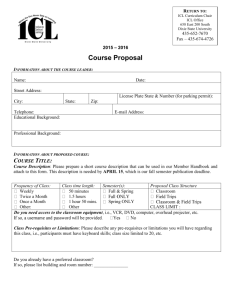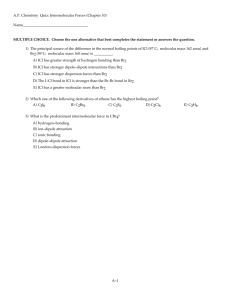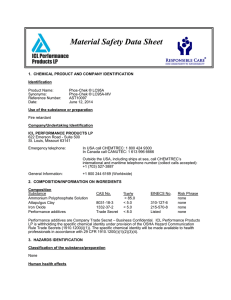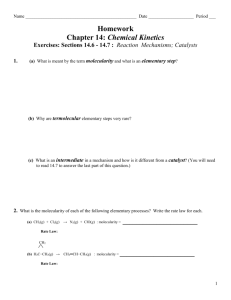Null subjects without * UCL Working Papers in Linguistics
advertisement
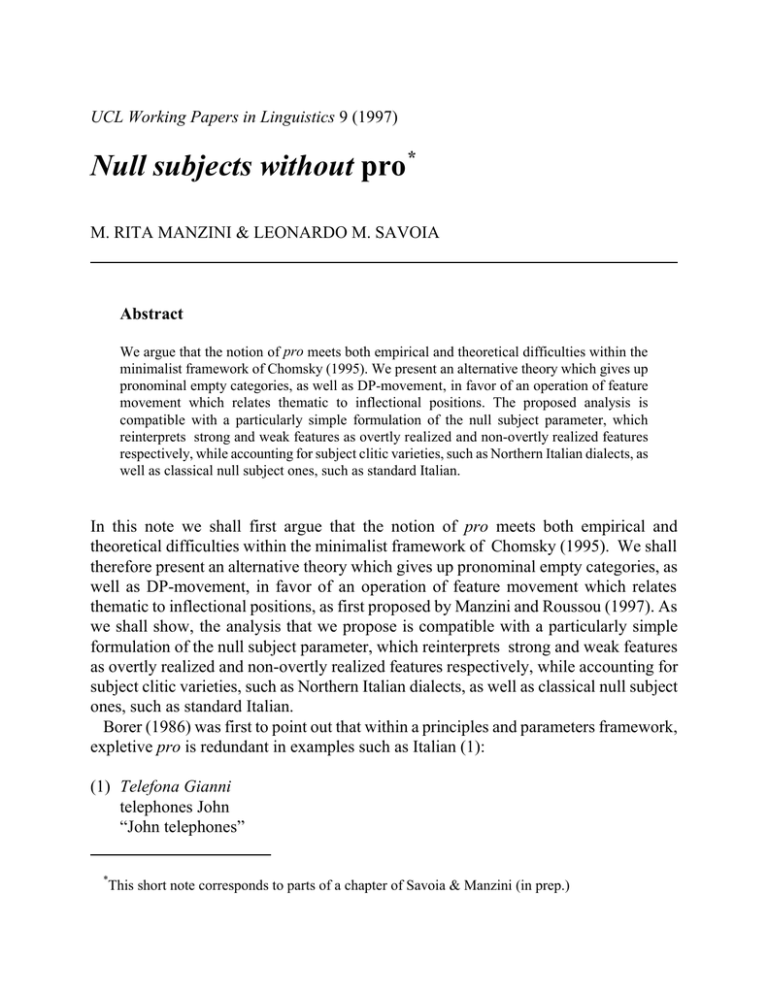
UCL Working Papers in Linguistics 9 (1997) Null subjects without pro* M. RITA MANZINI & LEONARDO M. SAVOIA Abstract We argue that the notion of pro meets both empirical and theoretical difficulties within the minimalist framework of Chomsky (1995). We present an alternative theory which gives up pronominal empty categories, as well as DP-movement, in favor of an operation of feature movement which relates thematic to inflectional positions. The proposed analysis is compatible with a particularly simple formulation of the null subject parameter, which reinterprets strong and weak features as overtly realized and non-overtly realized features respectively, while accounting for subject clitic varieties, such as Northern Italian dialects, as well as classical null subject ones, such as standard Italian. In this note we shall first argue that the notion of pro meets both empirical and theoretical difficulties within the minimalist framework of Chomsky (1995). We shall therefore present an alternative theory which gives up pronominal empty categories, as well as DP-movement, in favor of an operation of feature movement which relates thematic to inflectional positions, as first proposed by Manzini and Roussou (1997). As we shall show, the analysis that we propose is compatible with a particularly simple formulation of the null subject parameter, which reinterprets strong and weak features as overtly realized and non-overtly realized features respectively, while accounting for subject clitic varieties, such as Northern Italian dialects, as well as classical null subject ones, such as standard Italian. Borer (1986) was first to point out that within a principles and parameters framework, expletive pro is redundant in examples such as Italian (1): (1) Telefona Gianni telephones John “John telephones” * This short note corresponds to parts of a chapter of Savoia & Manzini (in prep.) 2 Manzini & Savoia Since Case, Agreement and thematic properties are all borne by Gianni, it is difficult to see how expletive pro can be justified except on strictly theory-internal grounds, notably with respect to the Extended Projection Principle (EPP) of Chomsky (1981). Within the minimalist framework of Chomsky (1995), even this justification for pro becomes problematic. Indeed, as first pointed out by Platzack (1994), the minimalist EPP is perfectly consistent with a derivation for (1) which takes the D-feature of I to be weak. If so, the [Spec, IP] position remains unrealized, by pro or other material, before SpellOut, while after Spell-Out the postverbal DP raises to this position to satisfy the weak D-feature. Alternatively, as proposed by Alexiadou and Anagnostopoulou (1997), Nash and Rouveret (1997), Pollock (1996), the D-feature of I is strong, but V is sufficient to check it, in the absence of DP-raising and/or pro. The problem takes on a different shape when it come to argument pro, as in Italian (2): (2) Telefona telephones “S/he telephones” In this case, within the principles and parameters framework, pro is the only element able to carry Case, - and Agreement features. Within a minimalist framework, its elimination is correspondingly more difficult. Consider first the approach of Platzack (1994), whereby the D-feature of I is weak in a pro-drop language like Italian. pro is necessary in (2) to check this D-feature; but if it is weak, we expect pro to be in VP-internal position before Spell-Out. As Donati and Tomaselli (1997) point out, an argument against this analysis is provided by the evidence presented by Cardinaletti (1994), to the effect that pro cannot be in the position of the postverbal subject in the overt syntax. A different kind of problem holds for theories such as Pollock’s (1997), that have recourse to V to check the D-feature of I, taken to be strong. In these theories, which apparently dispense with pro altogether, it is not clear what derives its argument interpretation. In particular, within the framework of Chomsky (1995), thematic roles are conceived of as assigned to XP positions within a VP-shell, following Hale and Keyser (1993). If so, it is not clear how they could be picked up by a V, albeit one capable of satisfying the EPP. In short, the role of pro in principles and parameters grammars is largely redundant, providing a clear simplicity argument in favor of its elimination. At the same time, there is one respect in which it appears to be uneliminable, namely the carrying of thematic properties. In addressing this apparent contradiction, we shall base ourselves on the work of Manzini and Roussou (1997), who independently build a grammar which eliminates N u l 3l subjects without pro PRO and A-trace The first crucial step in this grammar is a treatment of thematic properties as features, also argued for by Hornstein (1996) as a necessary move in building a theory of control without PRO. By feature, we understand simply an elementary property of syntax, that basic syntactic processes apply to. The choice of a theory of thematic structure is relatively less important. If a VP-shell approach is adopted, along the lines suggested by Larson (1988), Hale and Keyser (1993), Chomsky (1995), we can construe thematic features as corresponding to primitive predicates of some sort. If we adopt the Aspectual approach of Borer (1994), Arad (1996), we can identify thematic features with Asp features, such as Or (Originator of the event) or Meas (Measure of the event). For present purposes, we shall use a VP-shell notation, where each V bears an Asp specification. Concretly, under this approach, the predicate shell corresponding to a simple intransitive sentence takes the form in (3): (3) [VOrP John VOr [VP telephoned ]] The second crucial step in Manzini and Roussou’s (1997) elimination of PRO and Atrace is represented by the assumption that thematic, hence aspectual, features are weak, and do not therefore need to be satisfied as soon as they are introduced within the derivation. In other words, DP’s are not first introduced in a derivation in their thematic position, where they are arguably never seen. Rather DP’s are typically introduced in the derivation to satisfy strong features such as D. Concretely, the classical derivation of a simple intransitive sentence implies that a structure of the type in (3) is created at some stage of the derivation, while the need for feature checking subsequently determines movement of the subject from its original position to [Spec, IP], as indicated in (4): (4) [IP John I [VOrP John VOr [VP telephoned ]]] What Manzini and Roussou (1997) propose instead is that since Or is not a strong property, John is merged directly into [Spec, IP] to satisfy the strong D-feature of I, as indicated in (5): (5) [IP John I [VOrP VOr [VP telephoned ]]] Remember that the one respect in which pro appears to be motivated in structures of 4 Manzini & Savoia the type in (2) is as a conveyor of thematic properties to inflectional positions. Under the grammar in (5), the problem of connecting DP positions to Asp positions is generalized to lexical subjects as well. On the other hand, much work under the heading of the VPInternal Subject Hypothesis, from Koopman and Sportiche (1991) onwards, argues that the relation between Asp and DP is a movement one, precisely as in (4), since it obeys constraints on movement such as Chomsky’s (1995) MLC, or some other version of Minimality. Taking this evidence into account, Manzini and Roussou (1997) propose that the derivation of (5) simply includes a covert process of feature movement, whereby Or is attracted to the checking domain of DP. Technically, we say that every DP is associated with a [-interpretable] Asp feature that needs to be checked. It is on order to check this feature that a [+interpretable] Asp moves to the checking domain of DP, adjoining to the I head. By this mechanism of feature movement, the Or role is conveyed to the lexical DP subject in (6), as desired: (6) [IP John [Or - I] [VOrP VOr [VP telephoned ]]] The empirical debate between the derivation in (4) and the derivation in (6) centers on the evidence for or against the presence of a copy of the lexical DP in thematic position. In this debate, a theory of Asp-movement arguably has the upper hand. Chomsky (1995) notices that unlike traces of wh-movement, traces of DP-movement do not give rise to reconstruction effects. Thus under the derivation in (7), we might expect each other to receive a bound interpretation in its reconstructed position; this is in fact not possible: (7) [IP Each other I [VP seem to the boys [IP each other to [VP each other sleep ]]]] Chomsky (1995) therefore proposes that reconstruction should be understood as a property of operator-variable interpretation, and therefore restricted to wh-traces. In the grammar that we adopt, there is no need for such a stipulation. The DP-trace in the embedded [Spec, IP] in (7) can be eliminated simply by making the natural assumption that infinitival I, unlike finite I, is not associated with a strong D-feature. As for raising from thematic position to matrix [Spec, IP], we can express it precisely as movement of an Asp feature to the checking domain of DP. Thus the derivation in (7) translates into the derivation in (8): (8) [IP Each other [Or - I] [VP seem to the boys [IP to [VOrP VOr [VP sleep ]]]]] N u l 5l subjects without pro Since the only material that moves in (8) is the Or feature, we straightforwardly predict that there is no reconstruction effect for the lexical anaphor, which is directly merged at the matrix I. We are now in a position to proceed to the elimination of argument pro as well. Before turning to classical null subject languages such as Italian, we shall consider Northern Italian dialects, which fall somewhere in between these and classical non-null subject languages. Northern Italian dialects have an obligatory subject clitic, as illustrated with the variety of Firenze in (9). When a lexical subject is present, it doubles the subject clitic; sentences without subject clitic, whether a lexical subject is present or not, are ungrammatical: (9) a. b. La Maria *(la) viene The Mary she comes “Mary comes” Firenze *(La) viene She comes On the basis of the cluster of properties individuated by Rizzi (1982) as typical of null subject languages, Brandi and Cordin (1989), Rizzi (1986) conclude that Northern Italian dialects are null subject languages, and analyze the obligatory subject clitic as an inflection. The lexical subject in (9a) fills therefore the Spec of this inflection, which Cardinaletti and Roberts (1991) identify with AgrS under the Split-Infl hypothesis of Pollock (1989); pro fills the same position in (9b). Within the framework of Manzini and Roussou (1997), however, a straightforward alternative becomes available. Assuming as before that the subject clitic of Northern Italian dialects is an inflection, associated with a categorial D-feature, it will attract an Asp role. It is the movement of Asp to the subject clitic that contributes an argumental interpretation to the latter. More specifically, following the treatment of object clitics suggested by Sportiche (1992), we shall assume that subject clitics have their own projection, which we shall call ICl; the derivation of (9b) will then proceed by movement of Meas to ICl, as in (10): (10) [IClP Meas - la [IP viene [VMeasP VMeas [VP viene]]]] 6 Manzini & Savoia The question that arises next is how to treat the doubling of the clitic inflection by a lexical subject in (9a). There are empirical reasons to believe that the subject DP does not itself move to [Spec, ICl], but to a different position. To begin with, in a number of varieties, for instance the Padova variety studied by Benincà (1994), Poletto (1993), the Neg clitic precedes the 3p subject clitic; the lexical subject however precedes Neg, as illustrated in (11): (11) La Maria no la vien The Mary not she comes “Mary does not come” Padova On the assumption that the clitic Neg corresponds to an independent head, the conclusion that the lexical subject is in the Spec of a head higher than ICl is forced. Another argument can be based on the interaction of subject clitics with I-to-C movement in questions. This movement always leaves the subject clitic to the right of the inflected verb; the lexical subject however can only appear in a left- or right-peripheral position, as illustrated in (12), with the variety of Modena: (12) a. E-la gnuda la Maria? Is-she come the Mary “Has Mary come?” b. La Maria e-la gnuda? The Mary is-she come c. *E’ la Maria la gnuda? Is the Mary she come Modena Different approaches are possible to the ungrammaticality of (12c). Poletto (1997) assumes that the lexical subject is in a position above C. Savoia and Manzini (in prep.) on the other hand argue that the lexical subject occupies a Topic position; the impossibility of moving to an operator-like position like C across the Topic-like subject is therefore accounted for by the MLC. In either case, the impossibility of (12c), as opposed to (12a)-(12b), in itself provides an argument against generating the lexical subject in the same ICl projection as the subject clitic. Let us assume with Savoia and Manzini (in prep.) that the preverbal lexical subject is hosted in an ITop position between N u l 7l subjects without pro ICl and C, as indicated in (13), for (9a): (13) [ITopP la Maria [IClP la [IP viene ... While ICl is associated with the categorial D-feature, ITop is associated with a Topic feature. The checking of this latter feature by the DP subject is therefore independent of the checking of the D-feature by the subject clitic. By the natural assumption that functional projections reflect an universal hierarchy, as also suggested by Cinque (1997), we extend the nominal inflection ICl from Northern Italian dialects to all languages considered here. We are then in a position to provide a first systematization of the null subject parameter within the present framework. Classical non-null subject languages, such as English, are simply languages which overtly realize ICl, i.e. overtly check its D-feature, by merging a lexical DP in its Spec. Subject clitic languages, such as Northern Italian dialects, overtly realize ICl by merging a specialized subject clitic in its head. In terms of the parametric theory of Chomsky (1995) we can say that ICl is associated with a strong D-feature in this case as well. Merger in head rather than Spec position is however employed to check it. Let us then consider classical null subject languages such as standard Italian. It is natural to say, following in essence Platzack (1994), that the D-feature associated with ICl in Italian is weak; in other words that ICl is not overtly realized. This immediately predicts that lexical material is not merged either in its head or Spec position. In abstract syntax, on the other hand, we can assume that movement of Asp takes place exactly as detailed for English and Northern Italian dialects, triggered by the uninterpretable Asp feature associated with the (weak) D-feature of ICl.This in turn derives the argumental interpretation of ICl itself, as detailed in (14): (14) [IclP Or - 0 [IP telefona [VOrP VOr [VP telefona]]]] Remember now that according to Donati and Tomaselli (1997) the proposal that ICl is weak in Italian is undermined by Cardinaletti’s (1994) conclusion that pro is always overtly fronted. This in turn is based on the observation that a number of properties of null subject sentences contrast with those of sentences with post-verbal subjects. In the present framework without pro this observation must of course be independently explained. We have already seen in the discussion of subject clitic languages that the preverbal subject DP, when present, realizes a Topic position, ITop. Naturally enough, we 8 Manzini & Savoia can extend the same treatment to classical null subject languages, which share with subject clitic varieties the apparent optionality of subject DP’s. By contrast, Zubizarreta (1997), among others, argues that postverbal lexical subjects in Italian are in a Focus position. Concretely, we shall assume that the postverbal subject is in a predicate internal position, where it is stranded by leftward movement of the Verb and eventually of its complements. Thus the subject finds itself in the most deeply embedded position in the sentence, which is to be identified with its Focus according to Cinque (1993). In short, while the lexical subject in preverbal position is topicalized, the lexical subject in postverbal position is focussed. Remember that the former conclusion was extended from subject clitic to null subject languages; analogously the latter can hold for both types of languages. On the basis of the discussion that precedes, Cardinaletti’s (1994) generalization can be rephrased by saying that null subject sentences have properties that distinguish them from sentences with focussed subjects. This generalization in turn can easily be explained within the present pro-less framework. Indeed we independently know from Cinque (1993) that Focus/ Topic properties have correlates at the PF interface; thus focussed material bears primary stress, Topic material is destressed. The fact that null subjects have a number of properties that contrast sharply with those of postverbal subjects can simply be imputed to the fact that the latter are focussed; the former, being empty categories, hence pure features without phonological realization in the present approach, are of course (radically) destressed. We have not considered so far one question which figures in a particularly prominent way in most theories of null subjects, starting with Taraldsen (1978), namely the question of the relation between null subjects and verbal inflection. Contrary to Alexiadou and Anagnostopoulou (1997), Nash and Rouveret (1997), Pollock (1997), we exclude that any features of ICl are overtly checked by the raising of V, as is implicit in our acceptance of Platzack’s (1994) EPP parameter. Within the framework we are assuming, there is an immediate counterargument to overt raising of V to ICl. Indeed, as we already pointed out, in Northern Italian dialects a Neg head can intervene between a subject clitic and the inflected Verb in I; object clitics furthermore systematically intervene between the two positions. Under a rigid view of phrase structure, it is reasonable to expect that the positions of ICl and of I are equally separated by Neg and Cl in a null subject language like standard Italian; if so, overt raising of V to I Cl to check the EPP is excluded, since object clitics and Neg are systematically pre-verbal and not post-verbal. On the other hand, in the present framework not less than in preceding ones, a mechanism is necessary to insure that the inflectional features of ICl and I match when N u l 9l subjects without pro they are both overtly expressed; furthermore, if the ICl inflection remains unrealized, as in classical null subject languages, it can be recovered from the I inflection. It is useful to consider first subject clitic languages, which present the strongest evidence in favor of the existence of separate I and ICl projections. We have so far assumed that ICl is associated with a strong D-feature satisfied by the subject clitic; the latter is furthermore endowed with phi-features, which we can take to be +interpretable. Correspondingly, interpretable phi-features appear to be associated with the V in I. In order for the two sets of phi-features to agree, the lower set can be moved to the higher one. However, by the discussion that precedes, the higher set, associated with ICl, is +interpretable and, not being strong, cannot attract the lower -interpretable set generated on I. We can correct this problem by reverting to the idea of Chomsky (1995) that I itself is associated with a D-feature, again a -interpretable one. If this feature is weak it does not of course require overt satisfaction. At the same time, we can assume that like all D-features it attracts Asp. This will mean that Asp can only move to ICl via I. Asp itself can then take along the interpretable phi-features of I as free riders to ICl, yielding the desired agreement effect between I and ICl as a result. In other words, the derivation in (10) is to be completed as in (15): (15) [IClP Meas - la [IP Meas - viene [VMeasP VMeas [VP viene]]]] Consider next null subject languages. In this case, it is natural to assume with Pollock (1996) and others, that ICl is not associated with phi-features, and that it is I on the contrary that is associated with phi-features, that are +interpretable. At the same time, the analysis that we have just provided for subject clitic languages commits us to the assumption that I is also associated with a D-feature. If we took the latter to be +interpretable, it is obvious that we could dispense with I Cl in null subject languages altogether. However we reject this move on conceptual, if not on empirical grounds, in keeping with the hypothesis that the basic hierarchy of functional categories is not parametrized. Intuitively, we take ICl to be necessary precisely as a representation of D properties, even in languages where phi-features are +interpretable in I. As before, the mechanism for associating the phi-features of I with the pure D-feature of ICl can be identified with the raising of Asp from one position to the other, which takes the phifeatures of I along as free riders. Thus the derivation in (14) is to be refined as in (16): (16) [IclP Or - 0 [IP Or - telefona [VOrP VOr [VP telefona]]]] 10 Manzini & Savoia Finally, consider classical non-null subject languages like English, for which we have assumed that the strong D feature of ICl is overtly checked by the merger of a lexical DP in its Spec. Obviously the phi-features of DP are +interpretable, whilst the phi-features of V are not. Therefore if we want to move the phi-features of V to ICl for purposes of checking, we face the problem of +interpretable features attracting -interpretable ones once again. As before, we can circumvent this problem by having resort to the idea that I attracts Asp first, being associated with a -interpretable D feature; Asp movement to ICl takes then along the -interpretable phi-features of I as free riders, checking them against the DP in [Spec, I]. In this case, the question of what justifies the doubling of inflectional projections acquires even greater urgency. In the schema of derivation that we have postulated, only the D-feature of ICl is strong and therefore imposes overt merger of DP; but ICl could be dispensed with by simply assuming, with Chomsky (1995), that the Dfeature of I itself is strong. Nevertheless, in the absence of empirical evidence to the contrary, we take our analysis to be once again correct on conceptual grounds, in that it allows us to keep maximum consistency in underlying structure among the different types of languages examined. Thus the derivation in (6) is to be completed as in (17): (17) [IClP John [Or - ICl] [IP Or - I [VOrP VOr [VP telephoned ]]]] In conclusion, in terms of the present theory, the three-way parameter that opposes classical null subject languages such as Italian, subject clitic languages such as Northern Italian dialects and standard non-null subject languages such as English, is easily expressed in terms of whether the D-feature of ICl is overtly realized or not, and if it is, whether it is realized by a head or by a Spec. It appears in fact that at least as far as the null subject parameter is concerned, the notions of strong and weak feature of Chomsky (1995) can be substituted by the more transparent notions of overtly realized or non realized feature. The obligatory checking of a strong feature in overt syntax reduces to its overt realization; as for a weak feature, checked only in abstract syntax, it reduces of course to a non-realized feature. Standard Italian is a case of the D-feature not being realized; English and Northern Italian dialects on the other hand share the obligatory realization of this feature. However Northern Italian dialects possess a specialized head to realize it, while English does not, and therefore realizes it via its Spec. Our parametric schema is therefore as in (18): N u l11l subjects without pro (18) ICl realized ICl not realized as a head as a Spec Northern Italian English Standard Italian A second interesting dimension of parametric variation involving null subjects is represented by the presence or absence of agreement of the I and ICl inflections with postverbal subjects. Similarly, languages differ as to whether they impose definitess restrictions in one form or another on the postverbal subject itself. Considering these parameters is beyond the scope of the present note. Savoia and Manzini (in prep.) argue however that a treatment of such parameters within the framework sketched here is not only possible, but strongly motivated on empirical grounds. References Alexiadou. A. and E. Anagnostopoulou. 1997. Parametrizing Agr: Word-Order, V-movement and EPPchecking. Ms. FAS Berlin and University of Tilburg Arad, M. 1996. A minimalist view of the syntax-lexical semantics interface. UCL Working Papers in Linguistics 8:215-242 Benincà, P. 1994. La variazione sintattica. Bologna: Il Mulino Borer, H. 1986. I-Subjects. Linguistic Inquiry 17: 375-416 Borer, H. 1994. The projection of arguments. University of Massachusetts Occasional Papers 17 Brandi, L. e P. Cordin 1989. Two Italian dialects and the Null Subject parameter. In The Null Subject Parameter, ed. O. Jaeggli and K. Safir. Dordrecht: Kluwer Cardinaletti, A. 1994. Subject positions. GenGenP 2.1:64-78 Cardinaletti, A. and I. Roberts. 1991. Levels of representation of Agreement. Ms. Università di Venezia and Université de Genève Chomsky, N. 1981. Lectures on Government and Binding. Dordrecht: Foris Chomsky, N. 1995. The Minimalist Program. Cambridge, Mass: The MIT Press Cinque, G. 1993. A null theory of phrase and compound stress. Linguistic Inquiry 24: 239-298 Cinque, G. 1997. Adverbs and Functional Heads - A Cross-Linguistic Perspective. Ms., Università di Venezia Donati, C. and A. Tomaselli. 1997. La sintassi del soggetto nel quadro minimalista. Riflessioni su EPP e pro-drop. Lingua e Stile 32: 261-283 Hale, K. and J. Keyser. 1993. On argument structure and the lexical expression of syntactic relations. In The view from Building 20, ed. K. Hale and J. Keyser. Cambridge, Mass: The MIT Press Hornstein, N. 1996. On control. Ms., University of Maryland Koopman. H. and D. Sportiche. 1991. The position of subjects. Lingua 85: 211-258 12 Manzini & Savoia Larson, R. 1988. On the double object construction. Linguistic Inquiry 19: 335-391 Manzini, M.R. and A. Roussou. 1997. A minimalist theory of A-movement and control. Ms., UCL and Bangor Nash, L. and A. Rouveret. 1997. Proxy categories in Phrase Structure theory. Ms., Université de Paris VIII/ CNRS Platzack, C. 1995. Null subjects, weak Agr and syntactic differences in Scandinavian. Working Papers in Scandinavian Syntax 53:85-106 Poletto, C. 1993. La sintassi del soggetto nei dialetti italiani settentrionali. Padova: Unipress Poletto, C. 1997. The internal structure of AgrS and subject clitics. Ms., Università di Padova/ CNR Pollock, J.-Y. 1989. Verb-Movement, Universal Grammar and the structure of IP. Linguistic Inquiry 20:365-424 Pollock, J.-Y. 1997. Langage et cognition: Introduction au programme minimaliste de la grammaire générative. Paris: Presses Universitaires de France. Rizzi, L. 1982. Issues in Italian Syntax. Dordrecht: Foris Rizzi, L. 1986. On the status of subject clitics in Romance. In Studies in Romance Linguistics, ed. O. Jaeggli e C. Silva-Corvalan. Dordrecht: Foris Savoia, L. and M.R. Manzini. in prep. I dialetti italiani. Bologna: Il Mulino Sportiche, D. 1992. Clitic constructions. Ms., UCLA Taraldsen, T. 1978. On the NIC, vacuous application, and the that-t Filter. Ms., MIT Zubizarreta, M.-L. 1997. Prosody, Focus and Word Order. Ms., University of Southern California
